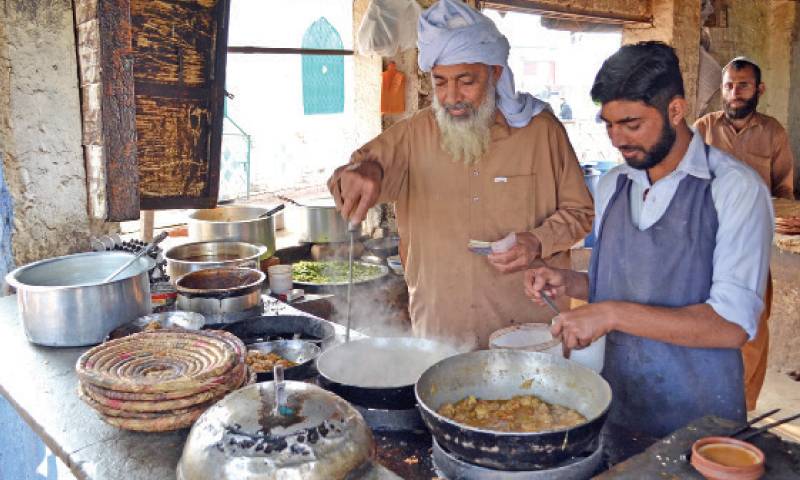The observant traveler on the Grand Trunk Road may have noticed remains of old structures and wells in varying degrees of decay at spots along this great highway. As late as the 1950s, these ruins marked the landscape at regular intervals and were visible from afar because each of these spots had an old banyan tree with hanging roots that almost touched the ground. These relics of a glorious past were, what had once been caravan ‘serais’, spaced out at a day’s journey and constructed in the shape of a complex, consisting of sleeping rooms, storage rooms, a ‘police’ post, water tank, well and the trade mark banyan tree. Many of these places are now gone, but the trees or their descendants can still be seen.
People travelling along highways in those days of old, rode horses, camels, carriages, bullock carts or ‘baillies’ and some even walked long distances. These travellers usually formed groups for safety purposes against ‘thugs’ and carried their own rations, which were cooked as camp was made. Centuries rolled by and cities sprouted along Sher Shah Suri’s great enterprise; asphalt replaced dirt and stone paving; modern transport pushed horses, camels, carriages and carts into near oblivion and we saw the appearance of, what we now know as, the Driver Hotel.
In our own time, we hear daily references to an art form that originated from the gaily painted trucks that ply sub continental roads. Known and preserved as truck art, we tend to overlook another icon without which the trucking culture would perhaps be incomplete. The Driver Hotel or, known in some areas as, the Truck Driver Hotel is a unique place. It combines a cheap means of sustenance to travellers and a spot where one can feel the real pulse of the Nation. It is also a spot, which embodies the diversity that makes us a colourful and great nation.
My love affair with these eateries began, when I took up a career that involved a lot of travelling through the length and breadth of the country. It was my driver, who initiated me to stop, rather reluctantly, at a ramshackle place near Sahiwal (then known as Montgomery). The mud and thatch building had a couple of bedsteads and rickety tables laid out in front. We ordered ‘daal’, which arrived in a surprisingly short time accompanied by hot ‘tandoori rotis’ on a ‘chungair’ (the traditional shallow basket like plate woven out of reed bark). The meal changed my whole outlook on food and captured me ‘hook, line and sink’. It is since that day in the early sixties that I (and now my entire family) have avoided swanky restaurants when travelling and make a bee line to rustic looking eating places along the road. Our criterion for selecting the ‘waterhole’ is simple – look for the spot that has maximum parked trucks around it. We do this because of the notion that truck drivers are the most reliable food critics.
Our affair with roadside eating places has led us to discover some great and unlikely spots. Take for example the small establishment on the road between Barian and Nathiagali. It was during our annual migration to cooler climes that we suddenly entered a stretch of road, where the light suddenly diminished. On looking around, we saw that we were passing through a dense cedar forest infested with monkeys. Rounding a bend, we came upon a small tin roofed ‘tandoor’. We turned into a clearing next to the spot and asked if the owner served something for lunch. He said that we should wait a few minutes and he would give us his specialty - stir fried wild beans. As we sat on rusted wrought iron chairs, a boy was dispatched into the surrounding forest, to return a few minutes later with an armful of green flat beans. The meal that followed, beat any that I had taken even in the most expensive of restaurants. The whole experience was enhanced by the surroundings and the fact I ate, while perched on the warm ‘tandoor’ counter.
I discovered another spot, between Sarai Sualeh and Havelian on the road to Abbottabad. Our decision to stop was prompted by the large congregation of trucks around the place and once again we found unforgettable cuisine made out of fresh okra plucked from a field immediately behind the hotel.
Perhaps one of these days I will write a book on Driver Hotels and dedicate it to their wonderful cooks, who are perhaps our most well-kept culinary secret. For now, I shall dedicate this week’s piece to this great category of people with the free advice that if any of my readers has not savoured their menu they must do so immediately.
Friday, April 19, 2024
Ode to driver hotels

The writer is a historian
US vetoes Palestine’s bid for full UN membership
8:27 AM | April 19, 2024
20pc Discos employees involved in power theft: Minister
April 19, 2024
Five govt officials shot dead in D I Khan
April 19, 2024
Parvez Elahi’s indictment delayed again in two cases
April 19, 2024
Hepatitis Challenge
April 18, 2024
IMF Predictions
April 18, 2024
Wheat War
April 18, 2024
Rail Revival
April 17, 2024
Addressing Climate Change
April 17, 2024
Justice denied
April 18, 2024
AI dilemmas unveiled
April 18, 2024
Tax tangle
April 18, 2024
Workforce inequality
April 17, 2024
New partnerships
April 17, 2024
ePaper - Nawaiwaqt
Advertisement
Nawaiwaqt Group | Copyright © 2024





